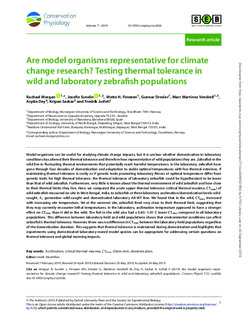| dc.contributor.author | Morgan, Rachael | |
| dc.contributor.author | Sundin, Josefin | |
| dc.contributor.author | Finnøen, Mette Helene | |
| dc.contributor.author | Dresler, Gunnar | |
| dc.contributor.author | Vendrell, Marc Martinez | |
| dc.contributor.author | Dey, Arpita | |
| dc.contributor.author | Sarkar, Kripan | |
| dc.contributor.author | Jutfelt, Fredrik | |
| dc.date.accessioned | 2019-09-24T10:23:26Z | |
| dc.date.available | 2019-09-24T10:23:26Z | |
| dc.date.created | 2019-06-25T12:37:13Z | |
| dc.date.issued | 2019 | |
| dc.identifier.issn | 2051-1434 | |
| dc.identifier.uri | http://hdl.handle.net/11250/2618439 | |
| dc.description.abstract | Model organisms can be useful for studying climate change impacts, but it is unclear whether domestication to laboratory conditions has altered their thermal tolerance and therefore how representative of wild populations they are. Zebrafish in the wild live in fluctuating thermal environments that potentially reach harmful temperatures. In the laboratory, zebrafish have gone through four decades of domestication and adaptation to stable optimal temperatures with few thermal extremes. If maintaining thermal tolerance is costly or if genetic traits promoting laboratory fitness at optimal temperature differ from genetic traits for high thermal tolerance, the thermal tolerance of laboratory zebrafish could be hypothesized to be lower than that of wild zebrafish. Furthermore, very little is known about the thermal environment of wild zebrafish and how close to their thermal limits they live. Here, we compared the acute upper thermal tolerance (critical thermal maxima; CTmax) of wild zebrafish measured on-site in West Bengal, India, to zebrafish at three laboratory acclimation/domestication levels: wild-caught, F1 generation wild-caught and domesticated laboratory AB-WT line. We found that in the wild, CTmax increased with increasing site temperature. Yet at the warmest site, zebrafish lived very close to their thermal limit, suggesting that they may currently encounter lethal temperatures. In the laboratory, acclimation temperature appeared to have a stronger effect on CTmax than it did in the wild. The fish in the wild also had a 0.85–1.01°C lower CTmax compared to all laboratory populations. This difference between laboratory-held and wild populations shows that environmental conditions can affect zebrafish’s thermal tolerance. However, there was no difference in CTmax between the laboratory-held populations regardless of the domestication duration. This suggests that thermal tolerance is maintained during domestication and highlights that experiments using domesticated laboratory-reared model species can be appropriate for addressing certain questions on thermal tolerance and global warming impacts. | nb_NO |
| dc.language.iso | eng | nb_NO |
| dc.publisher | Oxford University Press | nb_NO |
| dc.rights | Navngivelse 4.0 Internasjonal | * |
| dc.rights.uri | http://creativecommons.org/licenses/by/4.0/deed.no | * |
| dc.title | Are model organisms representative for climate change research? Testing thermal tolerance in wild and laboratory zebrafish populations | nb_NO |
| dc.type | Journal article | nb_NO |
| dc.type | Peer reviewed | nb_NO |
| dc.description.version | publishedVersion | nb_NO |
| dc.source.volume | 7 | nb_NO |
| dc.source.journal | Conservation Physiology | nb_NO |
| dc.source.issue | 1 | nb_NO |
| dc.identifier.doi | 10.1093/conphys/coz036 | |
| dc.identifier.cristin | 1707539 | |
| dc.description.localcode | © The Author(s) 2019. Published by Oxford University Press and the Society for Experimental Biology. This is an Open Access article distributed under the terms of the Creative Commons Attribution License (http://creativecommons.org/licenses/ by/4.0/), which permits unrestricted reuse, distribution, and reproduction in any medium, provided the original work is properly cited. | nb_NO |
| cristin.unitcode | 194,66,10,0 | |
| cristin.unitname | Institutt for biologi | |
| cristin.ispublished | true | |
| cristin.fulltext | original | |
| cristin.qualitycode | 1 | |

